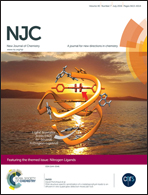New cyclometalated Ir(iii) complexes with bulky ligands with potential applications in LEC devices: experimental and theoretical studies of their photophysical properties†
Abstract
In the present work we report the synthesis and the electrochemical, photoluminescence and electroluminescence properties of two new Ir(III) cyclometalated complexes denoted as [Ir(F2ppy)2L1](PF6) and [Ir(F2ppy)2L2](PF6), where F2ppy is 2-(2,4-difluorophenyl)pyridine, L1 is 4,4′-diphenylethyl-2,2′-bipyridine and L2 is 4,4′-bis[2-[4-(1,1-dimethylethoxy)phenyl]ethyl]-2,2′-bipyridine. The photoluminescence spectra in solution for both the complexes are characterized by wavelength emission maxima at around 510 nm and higher quantum yields. In the solid state, the emission spectrum of the complex with L2 is characterized by higher emission intensity than the [Ir(F2ppy)2L1](PF6) complex. This behavior is explained as due to the effect of the more bulky structure of the L2 ligand, which prevents, in a more efficient way compared to the complex with L1, the auto-quenching processes in the solid packing. DFT calculations were performed to understand the photophysical behavior of the complexes, and an excellent agreement between experimental and theoretical data was observed. For the complex with L2, the electronic density of the HOMO is located in the chain and phenyl fragment of this ligand. This behavior is quite different from that expected for a typical Ir(III) cyclometalated complex, where the electron density of the HOMO is located on the metal (t2g orbitals)/phenyl fragment of the cyclometalating ligand. In spite of these differences, both complexes are good emitters, and in both cases the emission comes from a single T1 emitter state with the contribution of the MLCT and LLCT. In order to get a first approximation of the behavior of these complexes in LEC (light emitting electrochemical cells) applications, the electroluminescence spectra with an applied bias of 12 V were obtained. Both the complexes show yellow-green emissions at around 550 nm, with (0.41, 0.48) and (0.45, 0.48) CIE coordinates for [Ir(F2ppy2)2L1](PF6) and [Ir(F2ppy2)2L2](PF6), respectively.


 Please wait while we load your content...
Please wait while we load your content...